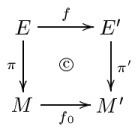 | ||
In mathematics, a Banach bundle is a vector bundle each of whose fibres is a Banach space, i.e. a complete normed vector space, possibly of infinite dimension.
Contents
Definition of a Banach bundle
Let M be a Banach manifold of class Cp with p ≥ 0, called the base space; let E be a topological space, called the total space; let π : E → M be a surjective continuous map. Suppose that for each point x ∈ M, the fibre Ex = π−1(x) has been given the structure of a Banach space. Let
be an open cover of M. Suppose also that for each i ∈ I, there is a Banach space Xi and a map τi
such that
The collection {(Ui, τi)|i∈I} is called a trivialising covering for π : E → M, and the maps τi are called trivialising maps. Two trivialising coverings are said to be equivalent if their union again satisfies the two conditions above. An equivalence class of such trivialising coverings is said to determine the structure of a Banach bundle on π : E → M.
If all the spaces Xi are isomorphic as topological vector spaces, then they can be assumed all to be equal to the same space X. In this case, π : E → M is said to be a Banach bundle with fibre X. If M is a connected space then this is necessarily the case, since the set of points x ∈ M for which there is a trivialising map
for a given space X is both open and closed.
In the finite-dimensional case, the second condition above is implied by the first.
Examples of Banach bundles
Morphisms of Banach bundles
The collection of all Banach bundles can be made into a category by defining appropriate morphisms.
Let π : E → M and π′ : E′ → M′ be two Banach bundles. A Banach bundle morphism from the first bundle to the second consists of a pair of morphisms
For f to be a morphism means simply that f is a continuous map of topological spaces. If the manifolds M and M′ are both of class Cp, then the requirement that f0 be a morphism is the requirement that it be a p-times continuously differentiable function. These two morphisms are required to satisfy two conditions (again, the second one is redundant in the finite-dimensional case):
Pull-back of a Banach bundle
One can take a Banach bundle over one manifold and use the pull-back construction to define a new Banach bundle on a second manifold.
Specifically, let π : E → N be a Banach bundle and f : M → N a differentiable map (as usual, everything is Cp). Then the pull-back of π : E → N is the Banach bundle f*π : f*E → M satisfying the following properties:
